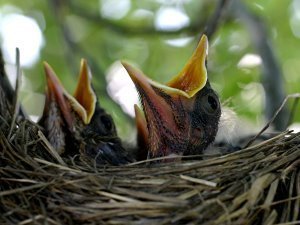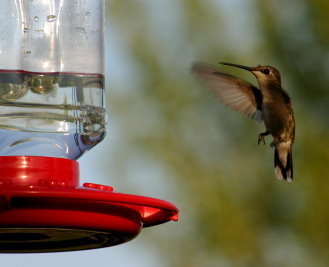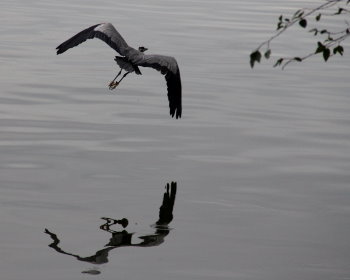





One of the best resources we have at Dave?s Garden is a group of members who garden in a professional capacity. Some are landscapers, others have a unique product, a few are experts in their chosen field, and some are qualified nursery folk, growing specialty plants and trees. From time to time, we?ll publish an article penned by one of them and they welcome your questions and comments. We hope you?ll enjoy reading about what they find interesting or intriguing.
 Great habitat for birds in your backyard includes clean and fresh high-quality feed, plenty of shelter, and lots of fresh and clean water for them to drink and bathe in. Native trees and shrubs are a bonus, and anything that has fruits or berries in your garden is sure to draw interest from the birds in season! Combining all of these things in your backyard is how you draw in birds that will stay all year around.
Great habitat for birds in your backyard includes clean and fresh high-quality feed, plenty of shelter, and lots of fresh and clean water for them to drink and bathe in. Native trees and shrubs are a bonus, and anything that has fruits or berries in your garden is sure to draw interest from the birds in season! Combining all of these things in your backyard is how you draw in birds that will stay all year around.
Black-oil sunflower seed is by far the best all-around seed you can put in your yard. It will attract a great diversity of birds, from goldfinches to chickadees. It stays fresh for a long time when exposed to the elements, and it keeps well in storage. The only downfall of the high-fat nut is that it does come in a shell, and the birds will make a mess with those shells when they're dropping them below your feeder. For that reason, it's a great idea to put a dish under your feeder, or simply move it around your yard frequently. Sunflower hearts are great to try if you live in an apartment or some other area where shells are not well tolerated.
Moving your feeders frequently is also good for ground-feeding birds such as Dark-eyed Juncos and White-crowned Sparrows, because it ensures the seed under the feeder (where they'll be attracted by all the other birds enjoying the perches) will be fresh and free from mold or an excessive amount of bird droppings (from those same birds enjoying the perches). Or, you can provide platform feeders along with hanging feeders. Platform feeders will attract any ground-feeding birds or any bird too big for the small perches on most hanging feeders.
 Some birds, such as hummingbirds and orioles, require additional tempting. Hummingbirds, of course, prefer nectar feeders. The choice of feeder is mostly an aesthetic one, though you should choose one that is easy to fill and clean. For hummingbirds, make nectar by combining one part white sugar to 4 parts water. You will need to heat the water so that it dissolves the sugar, but it's not necessary to boil the nectar. Be sure that the liquid is cool before you try to pour it into your feeder of choice!
Some birds, such as hummingbirds and orioles, require additional tempting. Hummingbirds, of course, prefer nectar feeders. The choice of feeder is mostly an aesthetic one, though you should choose one that is easy to fill and clean. For hummingbirds, make nectar by combining one part white sugar to 4 parts water. You will need to heat the water so that it dissolves the sugar, but it's not necessary to boil the nectar. Be sure that the liquid is cool before you try to pour it into your feeder of choice!
 Orioles will feed from a nectar feeder as well, but they need bigger feeding stations than hummingbirds, so a different feeder is necessary. Offering cut fruit such as halved or sliced oranges can also attract orioles and other frugivores. Fruit is best nailed to a tree or platform feeder (or attached to a special fruit feeder) to make it easy for birds to pull pieces away from the fruit, without letting them escape your view by absconding with the whole piece into the forest!
Orioles will feed from a nectar feeder as well, but they need bigger feeding stations than hummingbirds, so a different feeder is necessary. Offering cut fruit such as halved or sliced oranges can also attract orioles and other frugivores. Fruit is best nailed to a tree or platform feeder (or attached to a special fruit feeder) to make it easy for birds to pull pieces away from the fruit, without letting them escape your view by absconding with the whole piece into the forest!
Shelter for your birds is absolutely critical. Your garden will provide cover for birds while it is green and lush, but the best cover for birds in winter is from dense brush or coniferous plants. If you don't have any living shrubs in your yard this fall (and it's too late to plant them), don't worry! In the meantime, you can take dry plants from your garden and create a brush pile in your yard. The birds will enjoy picking any leftover tasty bits from the dry plants, and the pile will provide great cover for them throughout the winter.
The last piece in the puzzle that creates a true bird sanctuary year-round - is fresh, clean water. If you can provide this element throughout the winter with a heated bath for birds, you will have the ‘hoppingest' yard on the block, I guarantee it! Try to place your birdbath near cover and high enough to keep the birds out of reach of neighborhood cats. The type of bath you buy is, again, mostly aesthetic, but be sure that the bath is easy for you to clean when it's cold and snowy outside. A bath that attaches to a deck railing will be within easy reach when the snow starts drifting, and will also keep the bath within a reasonable distance of an electrical outlet for the heating element.
After all this preparation, all you have to do now is keep your binoculars and bird guide close to your windows, because you will have plenty to watch all winter long. Enjoy the outdoors!
Images courtesy of Melody Rose
Copyright © www.100flowers.win Botanic Garden All Rights Reserved